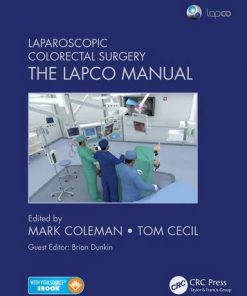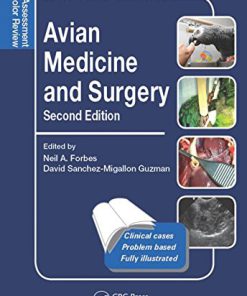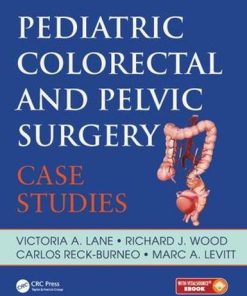Difficult Decisions in Colorectal Surgery 1st Edition by Neil Hyman, Konstantin Umanskiy ISBN 9783319402239 3319402234
$50.00 Original price was: $50.00.$25.00Current price is: $25.00.
Difficult Decisions in Colorectal Surgery 1st Edition by Neil Hyman, Konstantin Umanskiy – Ebook PDF Instant Download/Delivery: 9783319402239 ,3319402234
Full download Difficult Decisions in Colorectal Surgery 1st Edition after payment 
Product details:
ISBN 10: 3319402234
ISBN 13: 9783319402239
Author: Neil Hyman, Konstantin Umanskiy
Difficult Decisions in Colorectal Surgery 1st Edition Table of contents:
Chapter 1: Introduction
Tell Me a Story. The Importance of an Anecdote
Information Literacy. Learning the New Language
Bringing It Together
Why This Book?
References
Chapter 2: Evaluating Evidence
Introduction
Initial Evaluation
Stratifying Evidence
Random Error and Systematic Error (Bias)
Methodological Limitations (Bias)
Confidence in Effect
Downgrading Evidence
Imprecision
Inconsistency
Indirectness
Publication Bias
Upgrading Evidence
Large Magnitude of Effect
Plausible Confounders
Dose Response Gradient
Overall Quality Rating
Conclusion
References
Part I: IBD
Chapter 3: IBD: Management of Symptomatic Anal Fistulas in Patients with Crohn’s Disease
Introduction
Search Strategy
Results
Scenario 1: The Patient with a Simple Fistula and No Macroscopic Rectal Disease
Scenario 2: The Patient with Either a Simple or a Complex Fistula and Macroscopic Rectal Disea
Scenario 3: The Patient with a Complex Fistula and No Macroscopic Rectal Disease
Recommendations Based on the Data
A Personal View of the Data
References
Chapter 4: IBD: Management of a Painful Anal Fissure and Skin Tags in Patients with Crohn’s Di
Introduction
Search Strategy
Data Review/Recommendations
Personal View of the Data
References
Chapter 5: IBD: Elective Surgical Management in Patients with Ulcerative Colitis-How Many Stages?
Introduction
Search Strategy
Results
Diverting Loop Ileostomy
Initial Colectomy Prior to IPAA
Recommendations Based on the Data
A Personal View of the Data
References
Chapter 6: Which Ulcerative Colitis Patients Should Not Have Ileal Pouch-Anal Anastomosis
Search Strategy
Results
Recommendations
Personal View
References
Chapter 7: Management of Pouch-Vaginal Fistulas
Introduction
Search Strategy (See Table 7.1)
Results
Perineal Approach
Biological Therapy
Transanal Ileal Advancement Flap
Transvaginal Repair
Gracilis Muscle Interposition Flap
Transanal Pouch Advancement
Abdominoperineal Approach
Diversion
Recommendations
Personal View of the Data
References
Chapter 8: Crohn’s Colitis and Ileal Pouch Anal Anastomosis
Introduction
Methods
Results
Recommendations Based on the Data
A Personal View of the Data
References
Chapter 9: Steroid Management in Patients Undergoing Surgery for IBD
Introduction
Search Strategy
Results
Recommendations Based on Data
Personal View of Data
References
Chapter 10: IBD: Management of Dysplasia in Patients with Ulcerative Colitis
Introduction
Search Strategy
Results
Incidences of Dysplasia and Colorectal Cancer (CRC)
Disease Defined Risk Factors: Disease Duration, Age of Onset, Disease Extent, PSC
Patient Defined Risk Factors: Family History of CRC, Medication Usage, Smoking, Patient Awareness
Classification of UC Dysplasia
Dysplasia Management
Neoplastic Progression
Flat LGD
High Grade Dysplasia
DALMS
ALMS
A Personal View of the Data
References
Chapter 11: Post-operative Prophylaxis in Patients with Crohn’s Disease
Introduction
Recurrence in Post-operative Crohn’s
Risk Factors for Relapse
Patient Factors
Crohn’s Disease Behavior
Surgical Factors
Assessment of Recurrence
Non-invasive Methods of Assessing Post-operative Recurrence
Symptoms After Surgery Are Not Necessarily due to Recurrence
Medical Prophylaxis Options
Minimal Benefit: Probiotics/5-ASA/Corticosteroids
Moderate Benefit: Antibiotics/Immunomodulators
High Benefit: Biological Therapy
Authors’ Approach to Post-operative Crohn’s Patients
References
Part II: Colon Cancer
Chapter 12: Follow-Up in Patient’s After Curative Resection for Colon Cancer Surveillance for C
Introduction
Search Strategy
Results
Guidelines
MRI and PET Scans
Overall Utility
Personal Review of the Data
References
Chapter 13: Management of Patients with Acute Large Bowel Obstruction from Colon Cancer
Introduction
Methods: Search Strategy
Results
Self-Expanding Metal Stents (SEMS)
Stenting as Palliation
Stenting as a Bridge to Surgery
Conclusions
The Approach to the Patient with Obstructing Colon Cancer
References
Chapter 14: Utility of Primary Tumor Resection in Asymptomatic, Unresectable Metastatic Colon and
Introduction
Search Strategy
Results
Overall Survival
Chemotherapy and Survival
Metastatic Disease Burden and Survival
Further Considerations
Acute Surgery During Chemotherapy
Postoperative Complications: Elective Versus Acute Surgery
Systemic Inflammation and Primary Resection
Recommendations
Personal View of the Data
References
Chapter 15: Management of Large Sessile Cecal Polyps
Overview/Introduction
Treatment Options
EMR and Laparoscopic Inspection
ESD and Laparoscopic Inspection
Laparoscopic-Facilitated Colonoscopic Polypectomy Method
Laparoscopic “Wedge” Partial Circumference Full Thickness Resection
Standard Segmental Bowel Resection
Treatment Algorithm
Polyp Characteristics
Location
Algorithm (for Polyps That Do Not Fall into the Above Categories) (Table 15.2)
Conclusion
References
Chapter 16: Stage II Colon Cancer: Towards an Individualized Approach
Introduction
Search Strategy
Results
Non-risk Stratified Patients
Risk-Stratification-Clinical and Pathologic Factors
Risk-Stratification-Molecular Factors
Risk-Stratification-Gene Expression Profiling
Recommendations Based on the Data
A Personal View of the Data
References
Part III: Rectal Cancer
Chapter 17: Rectal Cancer: Management of T1 Rectal Cancer
Introduction
Search Strategy
Results
Oncologic Outcomes
Local Recurrence
Distant Metastasis
Overall Outcome
Quality of Life
Other Studies
Evidence Based Recommendations
A Personal View/Approach
References
Chapter 18: Management of T2 Rectal Cancer
Introduction
Search Strategy
Surgical Decision Making
Recommendations
Author’s Approach
Conclusions
References
Chapter 19: Clinical Complete Response after Neoadjuvant Chemoradiotherapy in Rectal Cancer: Operat
Introduction
Uncertainties about Tumor Response to Neoadjuvant Therapy
Treatment Options for Patients with a cCR after Neoadjuvant Therapy: Observation or Surgery?
Evidence Supporting NOM
Local Regrowth and Salvage Therapy vs. Stoma Rates and Operative Mortality
Functional Outcomes and Toxicity Associated with NOM
Non-Operative Management in the Elderly
Future Prospective Studies
Expert Opinion
References
Chapter 20: Management of the Patient with Rectal Cancer Presenting with Synchronous Liver Metas
Introduction
Search Strategy
Results
Evaluation of the Patient with Rectal Cancer and Synchronous Hepatic Metastasis
Treatment Options
Recommendations Based on the Data
Evaluation of the Rectal Cancer Patient with Synchronous Hepatic Metastasis
Treatment Options: Multimodality Treatment
Treatment Options: Surgical Approach
A Personal View of the Data
Summary of Recommendations
References
Chapter 21: Who Needs a Loop Ileostomy After Low Anterior Resection for Rectal Cancer?
Introduction
Methods
Why Not Divert?
Does Fecal Diversion Decrease Anastomotic Leak Rate?
Who Is at Highest Risk for Developing a Leak?
What Type of Diverting Ostomy Should We Use?
Personal View of the Data
References
Chapter 22: Selection Factors for Reoperative Surgery for Local Recurrent Rectal Cancer
Introduction
Search Strategy
Results
Recommendations Based on the Data
A Personal View of the Data
Abstracted Recommendations
References
Part IV: Anal Dysplasia/Cancer
Chapter 23: Anal Dysplasia/Cancer: Management of Patients with AIN 3
Introduction
Search Strategy
Results
Prevention
Treatment
Expectant Management
Recommendations Based on the Data
Personal View of the Data
References
Chapter 24: Management of the Abnormal Pap Smear in HIV Positive Patients
Introduction
Methods
Results
Recommendations Based on the Data
A Personal View of the Data
References
Part V: Benign Colon Disease
Chapter 25: Indications for Surgery in Patients with Severe Clostridium Difficile Colitis
Introduction
Search Strategy
Results
Recommendations Based on the Data
Personal View of the Data
References
Chapter 26: Do We Need to Operate on Patients After Successful Percutaneous Drainage of a Diver
Introduction
Search Strategy
Results
Recommendations Based on the Data
A Personal View of the Data
References
Chapter 27: The Role of Laparoscopic Peritoneal Lavage in the Operative Management of Hinchey II
Introduction
Search Strategy
Results
Results of Low and Very-Low Quality Studies
Results of Randomized-Controlled Trials
Recommendations Based on the Data
Personal View of the Data
References
Chapter 28: Surgery for Acute Complicated Diverticulitis: Hartmann vs. Primary Anastomosis
Introduction
Methods/Search Strategy
Results
Randomized Control Trials (RCTs)
Meta-analyses
Database Studies
Retrospective/Prospective Cohort Studies
Focus on Mortality
Focus on Anastomotic Leak
Recommendations Based on Data
Personal View of Data
References
Chapter 29: Who Needs Elective Surgery for Recurrent Diverticulitis?
Introduction
Search Strategy
Results
Uncomplicated Diverticulitis
Complicated Diverticulitis
Special Populations
Recommendations Based on the Data
Personal View of the Data
References
Chapter 30: Deciding on an IRA vs. IPAA for FAP
Setting the Stage
Aims of Surgery in Patients with FAP
The Surgical Options
How Are the Outcomes of Surgery to Be Judged?
Quality of Surgery
What Do the Data Say?
Recommendation
References
Chapter 31: Rectal Prolapse: What Is the Best Approach for Repair?
Introduction
Search Strategy
Results
Abdominal Verses Perineal Approach
Recurrence Rates
Function and Quality of Life
Morbidity and Mortality
Altemeier Verses Delorme’s Procedure
Recurrence Rates
Function and Quality of Life
Morbidity and Mortality
Posterior Rectopexy Without or With Resection
Recurrence Rates
Function and Quality of Life
Morbidity and Mortality
Laparoscopic Verses Open Rectopexy
Ventral Rectopexy
Recommendations
Personal View
References
Part VI: Benign Anal Disease
Chapter 32: Optimal Management of the Transsphincteric Anal Fistula
Introduction
Search Strategy
Results
Fistulotomy
Setons
Advancement Flaps
Biologic Products
LIFT Procedure
Conclusion and Personal View
References
Chapter 33: Benign Anal Disease: Management of the Recurrent Anovaginal/Rectovaginal Fistula
Introduction
Search Strategy
Results
Recommendations Based on the Data
A Personal View of the Data
References
Chapter 34: Benign Anal Disease: When to Operate on the Patient with an Anal Fissure
Introduction and Problem
Search Methods
Results
Recommendations
A Personal View of the Problem and the Data
References
Chapter 35: Anal Fissure: Recurrence After Lateral Internal Sphincterotomy
Introduction
Treatment Options
Search Strategy
Results
Recommendations Based on Current Data
A Personal View of the Data
Conclusion
References
Chapter 36: Benign Anal Disease: Third Degree Hemorrhoids – Who Really Needs Surgery?
Introduction
Search Strategy/Methods
Results
Control of Symptoms
Post-Treatment Pain and Complications
Lifestyle (Return to Work and Patient Satisfaction)
Cost
Recommendations
Expert Opinion
References
Chapter 37: Which Patients with Fecal Incontinence Require Physiologic Workup?
Introduction
Search Strategy
Results
Recommendations Based on the Data
Summary of Recommendation Options
A Personal View of the Data
References
Chapter 38: Benign Anal Disease: Who Are the Right Candidates for Sacral Nerve Stimulation?
Introduction
Search Strategy
Results
Recommendations Based on the Data
Recommendations
A Personal View of the Data
References
Chapter 39: When Is an Anal Sphincter Repair Indicated?
Introduction
Surgical Approaches to Fecal Incontinence
Anal Sphincter Repair
Predicting Outcome After Anal Sphincter Repair
Relationship of Short and Long Term Outcomes
Repeat Sphincteroplasty Outcomes
Reporting and Comparing Outcomes
Sacral Nerve Stimulation
Discussion
Conclusions
References
Part VII: Quality Improvement
Chapter 40: Checklists in Surgery
Introduction
Methods and Search Strategy
Results
Recommendations from the Data
Personal View of the Data
References
Chapter 41: Quality Improvement: Where Are We with Bowel Preps for Patients Undergoing Colon Rese
Introduction
Search Strategy
Results
Recommendations Based on Data
A Personal View of the Literature
References
Chapter 42: Quality Improvement: Are Fast Track Pathways for Laparoscopic Surgery Needed?
Introduction
Search Strategy
Results
Recommendations Based on the Data
Recommendations Based on the Data
A Personal View of the Data
References
Chapter 43: Quality Improvement: Enhanced Recovery Pathways for Open Surgery
Introduction
Methods
Search Strategy
Results
Complications
Readmission
Length of Stay
Cost
Quality of Life
Recommendations Based on the Data
A Personal View of the Data
How We Do It
References
Chapter 44: Quality Improvement: Preventing Readmission After Ileostomy Formation
Introduction
Search Strategy
Results
Recommendations Based on the Data
Personal Recommendations Based on the Data
References
Part VIII: Technique
Chapter 45: Trans-anal Endoscopic Surgery vs. Conventional Transanal Surgery
Results
Author’s View of the Data
References
Chapter 46: Laparoscopic Versus Robotic Versus Open Surgery for Rectal Cancer
Results: (A): Laparoscopic Surgery Versus Open Surgery for Rectal Cancer
Short Term Outcomes
Oncologic Outcomes
Results: Robotic Surgery Versus Laparoscopic Surgery for Rectal Cancer
Short Term Outcomes
Oncologic Outcomes
Recommendations
References
Chapter 47: Reservoir Construction After Low Anterior Resection: Who and What?
Introduction
Search Strategy
Results
Perioperative Outcomes
Straight CAA Versus Colonic J Pouch
Colonic J Pouch Versus Transverse Coloplasty
Side-to-End Versus Colonic J Pouch
Functional Outcomes
Straight CAA Versus Colonic J Pouch
Colonic J Pouch Versus Tranverse Coloplasty
Side-to-End Versus Colonic J Pouch
Summary of Comparisons
Recommendations Based on the Data
Personal View of the Data
Abstract of Recommendation
References
Chapter 48: Conventional vs Single Port Approaches to Laparoscopic Colectomy
Introduction
Search Strategy
Results
Perioperative Outcomes
Cost
Pain
Cosmetic Outcomes
Hernia Formation
Oncologic Outcomes
Recommendations
Personal View of the Data
Recommendations
References
Chapter 49: Anastomotic Leak Management Following Low Anterior Resections
Introduction
Search Strategy
Recommendations Based on the Data
Surgical Management of Anastomotic Leakage Following LAR in Patients with Generalized Peritonit
Reestablishing Intestinal Continuity in Patients with Symptomatic Anastomotic Leakage Following
A Personal View of the Data
References
Chapter 50: Management of the Unhealed Perineal Wound After Proctectomy
Introduction
Literature Search Strategy
Non-operative Strategies
Debridement
Local Antibiotic Agents
Negative Pressure Wound Therapy
Endoscopic Approaches: Sinusoscopy
Hyperbaric Oxygen Therapy
Operative Strategies
Omental Pedicle Grafts
Wide Excision and Split Thickness Skin Grafts
Gracilis Muscle Flap
Rectus Abdominus Myocutaneous Flap
Pudendal Flaps
Gluteus Maximus Flap
Meshes and Biological Implants
Conclusions
References
Erratum to: Difficult Decisions in Colorectal Surgery
Index
People also search for Difficult Decisions in Colorectal Surgery 1st Edition:
most difficult types of surgery
difficult decisions in surgery
difficult decisions in surgical ethics
difference between colorectal surgeon and general surgeon
Tags:
Neil Hyman,Konstantin Umanskiy,Difficult Decisions,Colorectal Surgery
You may also like…
Medicine - Oncology
Hereditary and Familial Colorectal Cancer 1st Edition Éanna Ryan
Relationships & Lifestyle - Diet & Nutrition
Medicine
Difficult Decisions in Vascular Surgery An Evidence Based Approach 1st Edition Christopher L. Skelly
Medicine - Veterinary Medicine
Medicine - Pediatrics
Case studies in pediatric colorectal and pelvic surgery 1st Edition Victoria A. Lane












